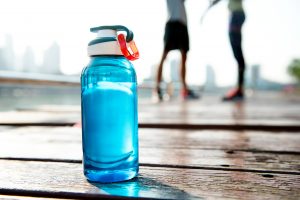 Even though it’s a dry heat, any temperatures over 90 degrees is still hot! Daytime temperature of 90 degrees are common in Chino Hills, CA in the summer. You need to take precautions and be smarter when you exercise in the heat. For instance, don’t workout in the middle of the day when it’s the hottest. Instead, working out in the morning, while it’s still cool can keep you safer, while still getting the exercise you need. After four in the afternoon works, too.
Even though it’s a dry heat, any temperatures over 90 degrees is still hot! Daytime temperature of 90 degrees are common in Chino Hills, CA in the summer. You need to take precautions and be smarter when you exercise in the heat. For instance, don’t workout in the middle of the day when it’s the hottest. Instead, working out in the morning, while it’s still cool can keep you safer, while still getting the exercise you need. After four in the afternoon works, too.
What you wear makes a difference.
Wear clothing that breathes and reflects heat. Natural cotton, linen and jersey help sweat evaporate easily and light colored clothes reflect the heat of the sun. There are newer materials made specifically for athletes that help keep you cooler and wick the sweat. Keep clothing loose to help the sweat evaporate and avoid chaffing.
Whether you’re exercising inside or outside, staying hydrated is important.
You should always have a bottle of water on hand when you workout. You lose a lot of fluid when you sweat in a tough workout. It’s even worse when you’re working out in the heat. Carry more than one bottle if you’re running any distance. Sip it every 15 minutes, even if you don’t feel like you’re thirsty. Check into hydration packs if you’re going a distance. If you’re exercising more than an hour in hot weather, a sports drink to replenish your electrolytes may be in order. Studies also show that taking a salt tablet with a sports drink helped marathon runners finish faster, but isn’t normally necessary for the average workout.
Choose your path wisely if you work outside.
Just like exercising outside in the morning to avoid the sun is good, so is exercising or running on a shaded path. The less exposure to the sun that you have, the cooler you’ll be. Don’t forget the sunscreen either. While you need some sun to help boost your vitamin D, those should be controlled exposures for short periods, not a full workout session or run.
- The best way to avoid heat stroke on hot summer days is to workout inside, in an air conditioned gym. Not only will you avoid heat stroke, you’ll avoid sunburn, too.
- Acclimate your body to the heat. If you’ve never exercised before, don’t try to do it all at once. Take more frequent breaks, reduce the intensity and make the workout shorter, gradually increasing the time.
- Pay attention to the warning signs of a heat related condition. Muscle cramps, weakness, nausea, fatigue, headache, dizziness, low blood pressure, increased heart rate, visual impairments and confusion are a few.
- Watch the weather forecast. If there’s a heat warning, make alternative plans to go to the gym or workout in your home where it’s air conditioned.
 13609 Central Ave, Ste E Chino, CA 91710
13609 Central Ave, Ste E Chino, CA 91710
